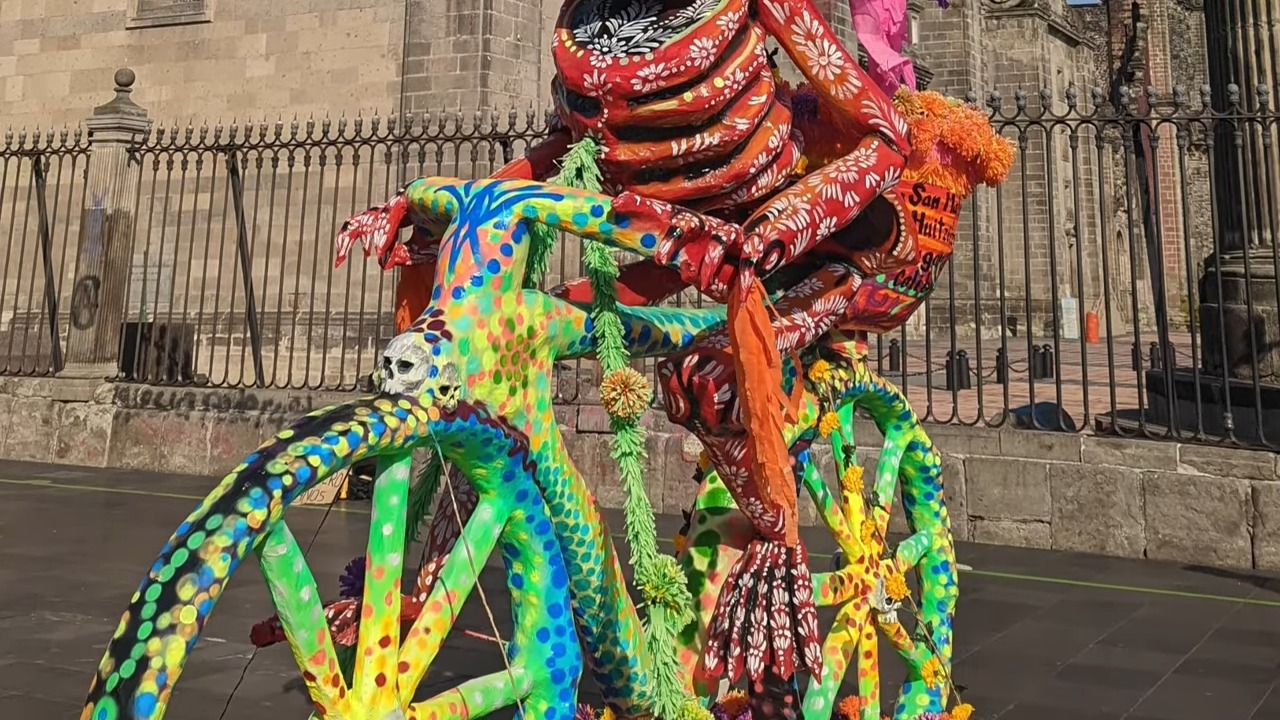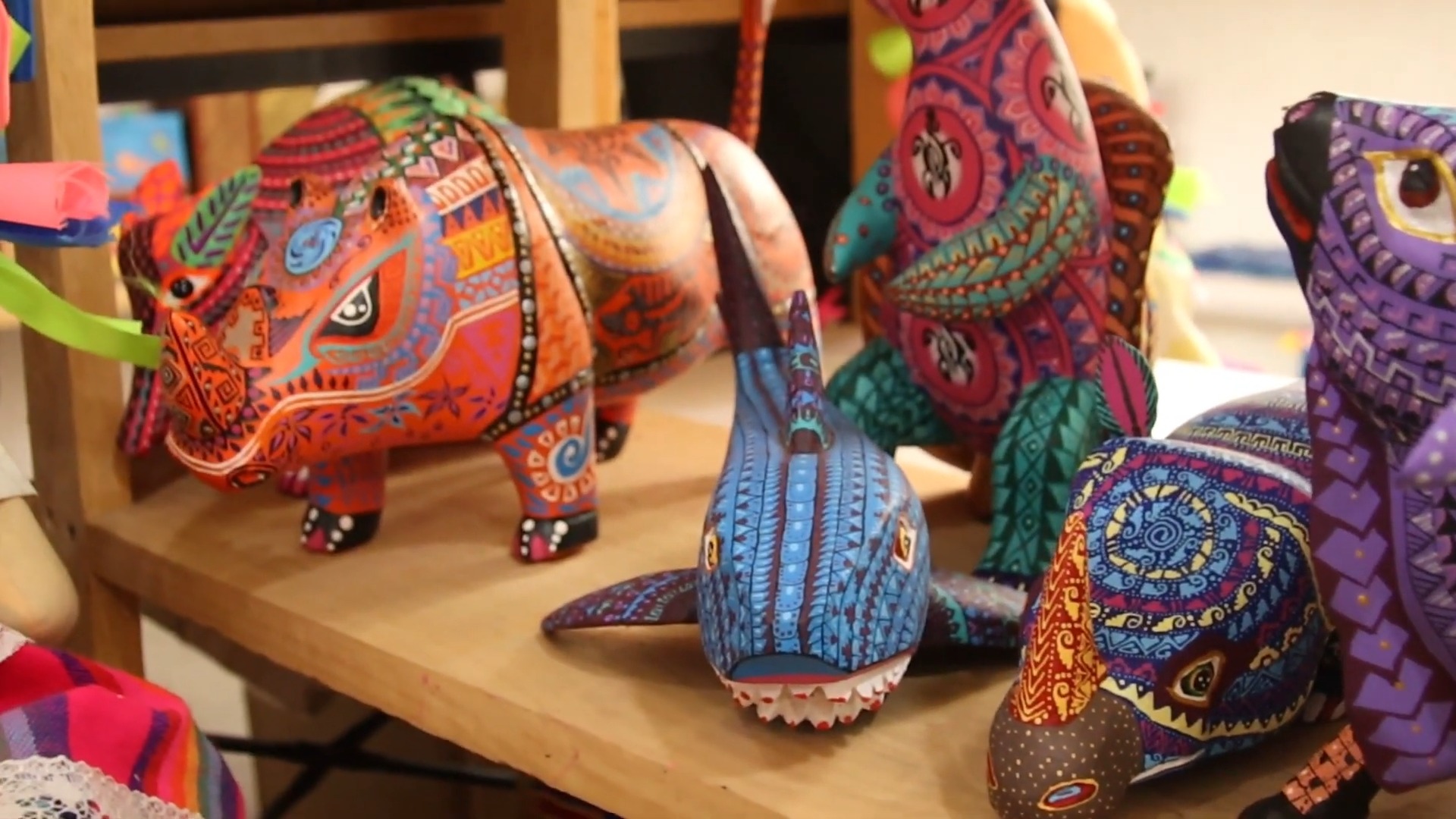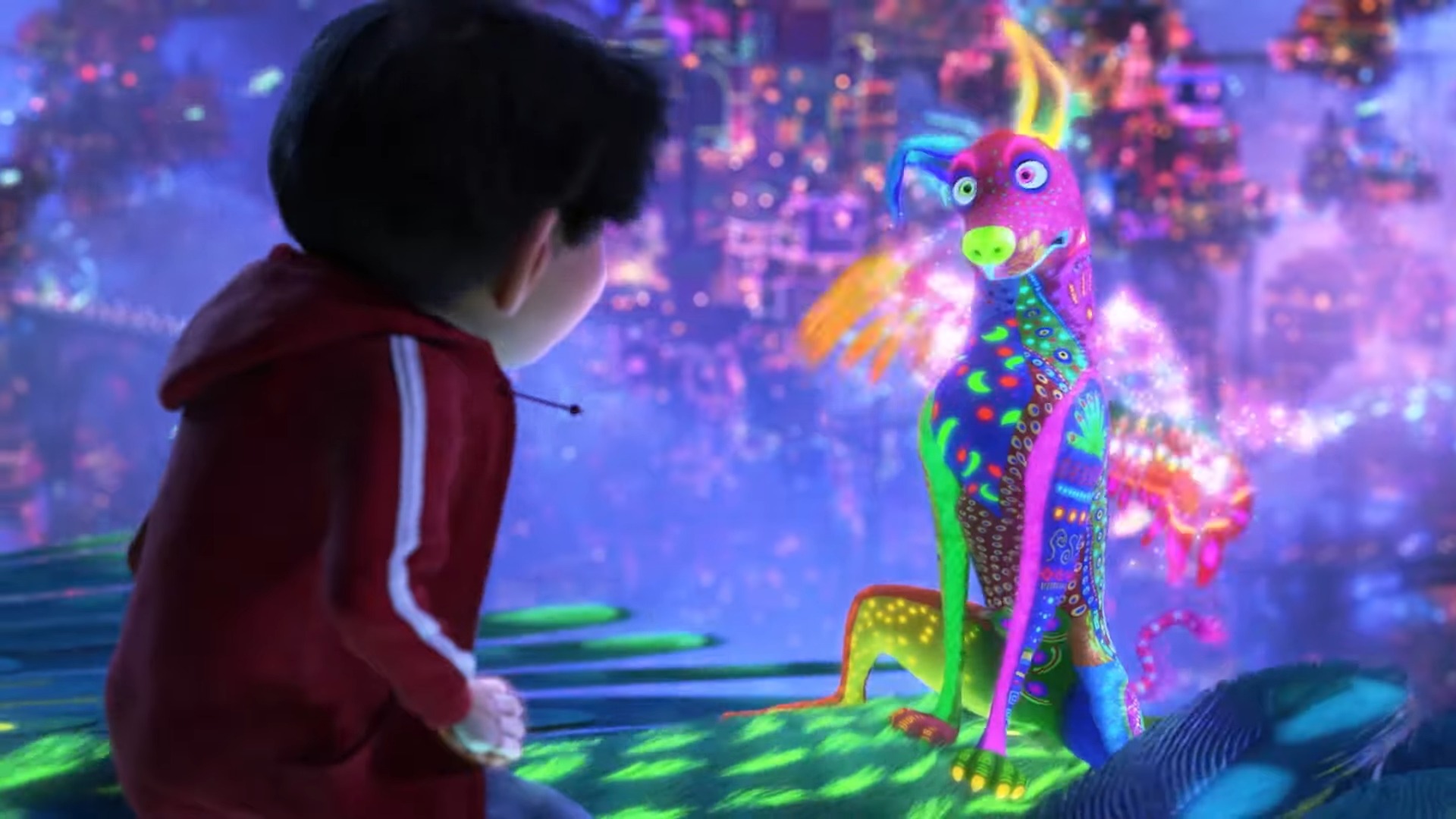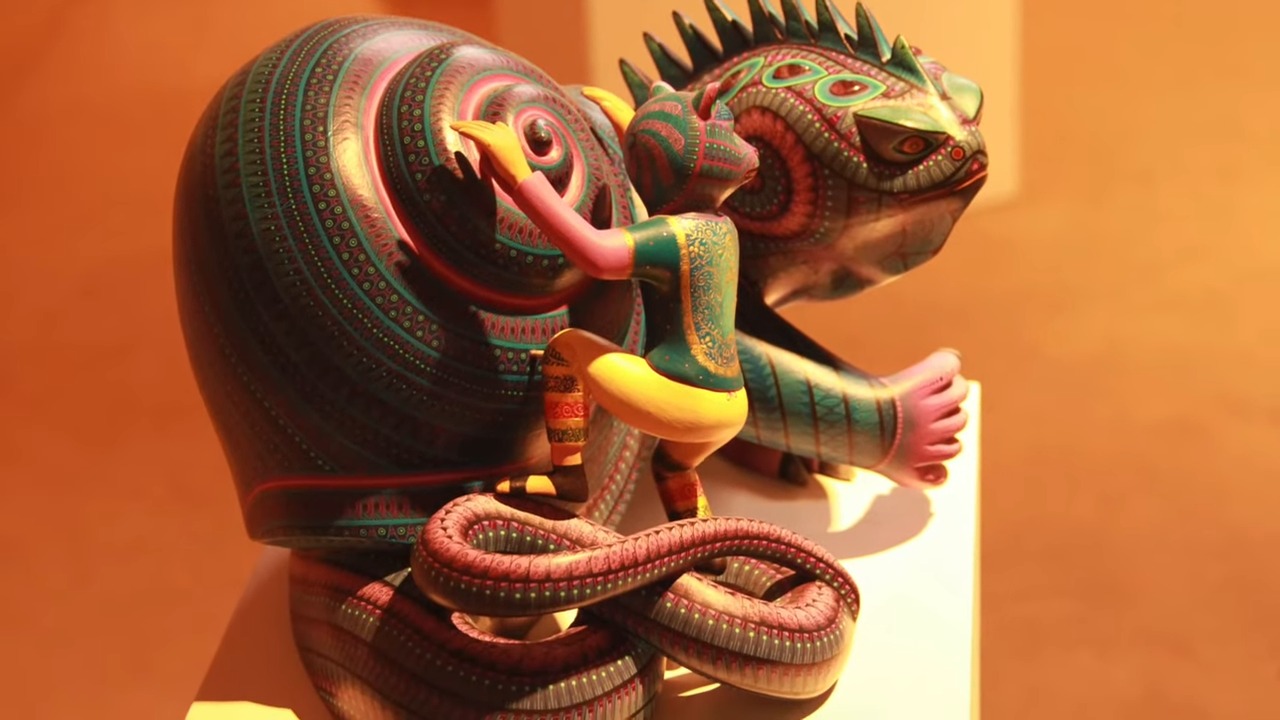Alebrijes are sculptures made of copal wood or cartonería, a Mexican handcraft similar to papier-mâché. They depict fantastical chimera-like creatures. For example, a single alebrije might consist of a wolf’s body, a bat’s wings, and a dragon’s head.
They are often brightly colored with detailed patterns, making them as enchanting as they are terrifying.
The Meaning
“Alebrije” is a ficticious word with no real definition. It is possibly a portmanteau, in which two or more words are combined (interestingly enough, much in the same way an alebrije is a combination of two or more creatures).
One conjecture is that it’s a combination of the Spanish words “Alegría,” meaning joy, “Bruja,” meaning witch, and “Embije,” meaning to paint or dye something. In other words, one could interpret “alebrije” to mean a witch (or a fantasy creature) painted with joy.
Alebrijes originated in 1936 from Mexico, and the first papercraft called Alebrijes attribute to Pedro Linares, a Mexican artist. Pedro Linares specialized in making carnival masks, “Judas” figures, and pinatas, and he used to sell them in La Merced and other markets. Linares work as a Papier-mâché artist was excellent.
What are the Origins of Alebrijes?
The word “alebrije” was coined by Mexican artist Pedro Linares López. According to lore, Linares became very ill at the age of 30. Succumbing to a high fever, he lost consciousness, then had a dream that he had returned to good health and was strolling in a strange, peaceful forest. As he continued to walk in this dream forest, the rocks, clouds and trees began to change shape, taking the form of chimera-like creatures.
Unsure of whether they were benevolent or evil, Linares heard the creatures chanting, “Alebrije! Alebrije! Alebrije!” Upon waking from this dream and recovering from his illness, Linares was then inspired to bring these creatures to life in the cartonería art tradition he had been practicing since his youth.
Who was Pedro Linares?
Pedro Linares was born in the La Merced area of Mexico City on June 29, 1906. Trained by his father in a family tradition passed down for generations, he became a cartonero—a craftsman of cartonería—at the young age of 12.
Linares specialized in crafting piñatas, “Judas” figures and masks, and continued to do so with very little renown while living in Mexico City up until the mid-1930s. In 1936 he became sick with peritonitis and experienced the visionary dream that led to his breakthrough in art with the conception of alebrijes.
Although the papier-mâché chimeras garnered little attention at first—“They were too ugly,” Linares said—he continued to refine them and make them more colorful.
“Linares was sick and was having these nightmares and vivid dreams, with a fever. And what a better way to fight those demons, with creativity and really conquering them”, said Lizabeth Ortiz,l ocal artist and curator.
Scary Strange Monsters
People were at first scared of the strange monsters and did not want to buy them. After being picked up by a prominent art gallery, they came to the attention of established artists Diego Rivera and Frida Kahlo, who immediately recognized the merit of his work and began to regularly commission his alebrijes.
Although Linares became well-recognized in Mexico after the popularization of his sculptures, it wasn’t until 1975, with the release of the documentary “Pedro Linares: Artesano Cartonero” by Judith Bronowski, that he rose to international recognition. With his growing fame, he traveled the world exhibiting his works and conducting workshops in which he taught his craft.
Among his most notable students is the Oaxacan artist Manuel Jimenez, who was already working in a different medium and took the alebrije concept in his own direction.
What is interesting to know is that these works of Pedro Linares are frequently present on custom patches.
The Old Tradition of the Nahual
Manuel used wood and the inspiration of the old tradition of the nahual. The nahual is the ancient Aztec belief in supernatural beings that have the capacity to transform themselves into animals. Jimenez combines the nahual tradition with the visions inspired by Linares to make his own version of alebrijes. There are around 150 families throughout Mexico dedicated to making these joyful monsters.
Death of Pedro Linares
In 1990 Pedro Linares was awarded the National Prize for Arts and Sciences. Two years later, at the age of 85, Linares died of complications from gastric ulcers, the same issue that led to his fevered dream state at the age of 30 and plagued him for most of his life.
He is survived by his three sons, his eight grandchildren, and his three great-grandchildren, many of whom carry on his craft and legacy to this day.
The Evolution of Alebrijes in Oaxaca
Introduced to alebrijes by Pedro Linares, Manuel Jiménez Ramírez brought the concept to his native town of San Antonio Arrazola in Oaxaca, Mexico. Although they were new to him, Jiménez was no newcomer to Mexican folk art and had already established himself as a gifted woodcarver. Manuel used wood and the inspiration of the old tradition of the nahual. The nahual is the ancient Aztec belief in supernatural beings that have the capacity to transform themselves into animals.
Jimenez combines the nahual tradition with the visions inspired by Linares to make his own version of alebrijes. This may be one of the reasons why the figures are also known as nahuatzkosquit. There are around 150 families throughout Mexico dedicated to making these joyful monsters. Furthermore, he was influenced by spirituality and distanced himself from Linares’ chimera-like dream creatures, preferring to carve animals based on the Mesoamerican folk religion of Nagualism.
Although woodcarving was already a major staple of Oaxaca, the success of Manuel Jiménez’s alebrijes led to an even greater popularization of and prosperity in the trade. There are now three major towns in Oaxaca whose main source of commerce relies on handcrafts: San Martin Tilcajete, San Antonio Arrazola and La Unión Tejalapan. It is not uncommon for an entire family to participate in the production of woodcraft, with men doing the majority of the harvesting and carving, while women typically take up the role of painting.
Because a signature increases the value of an alebrije, the most prominent member of the family will typically sign it alone, even if the rest of the family has aided in the production. And while Oaxacan artesanos continue to reap the rewards of their alebrije craft, it is not without its issues, as one negative impact of the booming woodcraft market is the depletion of copal trees. To further complicate matters, copal trees take a very long time to reach maturity and often fall victim to illegal harvesting.
Alebrijes Characters in the Coco Movie
In 2017 Disney released the movie “Coco,” a Pixar Animation film about Día de los Muertos and a boy who must travel to the land of the dead. In the movie, they appear true to their form, except that they’re bioluminescent spirit guides within the land of the dead. It should be noted that Alebrijes have nothing to do with the traditions of Día de los Muertos, nor were they conceived of as spirit guides.
This was a creative decision made by the producers on account of the alebrijes’ bright colors and otherworldly nature, which complemented the themes and aesthetic of the film. Nevertheless, “Coco” was an immense success, and it’s hard to ignore the awareness it has raised for various aspects of Mexican culture, including them.
Aside from the Pedro Linares family, another known Alebrije artist is Susana Buyo, who learned the Mexican folk art in one of Pedro Linares family’s workshops. Susana is a native of Argentina and a citizen of Mexico, and the local children referred to her as the “Señora de Los Monstruos.” Susana’s work is very evident in Mexico City and Europe.
The difference between her work and that of Pedro Linares is that she has included many tender expressions and human contours. Her work also uses non-traditional materials like fantasy stones, modern resins, and feathers for durability and novelty.
Alebrijes For Sale
Although you can find many replicas especially in the region of Oaxaca and the town of San Martin Tilcajete, it is very hard to find original Pedro Linares Alebrijes artwork for sale. The closest you can get is by buying from his family who keeps the Alebrijes art tradition alive in Mexico City.
Though he passed away in 1992, his work is now part of Mexican culture, some calling them spirit animals, that can ward off evil spirits.
Conclusion
Alebrijes are more than just vibrant, fantastical creatures; they are a testament to the rich cultural heritage and artistic ingenuity of Mexico. Originating from Pedro Linares’s fevered dream and further developed by artists like Manuel Jiménez Ramírez, these unique sculptures blend tradition, imagination, and craftsmanship.
Each of them tells a story, reflecting a combination of folklore, spirituality, and the personal touch of its creator. The continued evolution and popularity of alebrijes, both in traditional Mexican art and modern interpretations, underscore their significance and enduring appeal. They serve as a colorful reminder of the power of dreams, the importance of cultural preservation, and the limitless possibilities of artistic expression.




